

Exploration of Landscape Spatial Imagery in the Jiufeng Area of Songjiang, Shanghai, Based on Digital Humanities Technology
Received date: 2024-03-19
Revised date: 2024-06-25
Online published: 2025-03-22
Songjiang is often referred to as the "Cultural Root of Shanghai," with its rich history and cultural heritage playing a notable role in the region. Among its natural resources, Jiufeng stands out as the only mountain and forest resource in Songjiang, celebrating its unique natural beauty since the Yuan Dynasty. Over the centuries, Jiufeng has become one of the most renowned scenic spots in the Jiangnan region. Even today, it remains a crucial landmark for showcasing the local mountain and forest landscapes. The primary objective of this study was to conduct an in-depth exploration of the spatial imagery associated with the Jiufeng area. By identifying and understanding the unique landscape features of Jiufeng, this study aimed to reveal its historical appearance, thereby contributing to the preservation and development of traditional mountain and forest landscape culture of China. This study leverages rich historical and geographical information as well as spatial imagery embedded in classical Chinese poetry. Specifically, this study focuses on 639 poems on the Jiufeng area from the Yuan, Ming, and Qing dynasties. Utilizing digital humanities techniques, this study extracted landscape elements and emotional expressions from these poems, which were then synthesized into the overall spatial imagery of the Jiufeng landscape. The research findings reveal three key insights regarding the landscape imagery of the Jiufeng area in Songjiang, Shanghai. 1) The landscape features of Jiufeng can be categorized into two primary aspects: natural and cultural elements. Natural landscape elements, such as mountains, rivers, and forests dominate both in quantity and variety, indicating their notable role in the minds of local poets. These natural elements are not only abundant, but also prominently featured in poetic descriptions, far surpassing the depictions of cultural landscapes. Among cultural elements, architectural features are the most frequently portrayed. These structures, often closely connected to the historical and cultural heritage of the region, serve as important vessels for the emotional expressions of poets. 2) The emotional tone of the poems about Jiufeng is predominantly characterized by neutral and positive sentiments. This study identified a diverse range of emotions within the texts, with "joy," "ease," "nostalgia," and "sorrow" being the most commonly expressed emotions. Notably, the emotions of "nostalgia," "serenity," and "regret" are the most frequently mentioned, suggesting that poets often employed neutral and positive feelings to convey their experiences and reflections on the Jiufeng landscape. 3) The research culminates in the identification of five distinctive landscape imagery categories associated with the Jiufeng area. These categories are: "Autumn Moon Boating," which captures the dynamic and vibrant water scenes, depicting how people in ancient times enjoyed boating and frolicking under the moonlight; "Leisurely Seclusion," which reflects the role of Jiufeng as a place of retreat, where individuals could enjoy a tranquil and peaceful lifestyle; "Reflections on Song Mountain" and "Mountain Recollections," which highlight the cultural significance of Jiufeng as a site where scholars engaged in literary and artistic pursuits; and "Huating Scenery," which encapsulates the natural beauty of Jiufeng, expressing the deep admiration of poets for its picturesque landscapes. This study offers new perspectives for deepening the understanding of the Jiangnan Mountain and forest landscapes in the Jiufeng area of Songjiang through its methodologies and findings. First, the application of digital humanities techniques to analyze a large volume of text enhances research efficiency and provides more accurate results. Second, by analyzing the compositional elements of landscape imagery in the Jiufeng area, this study identified unique aspects of the landscapes of the region that serve as valuable reference materials for contemporary landscape designers. In summary, this research not only enriches the theoretical knowledge in this field, but also provides valuable guidance for practical applications, contributing to the advancement of high-quality landscape development.
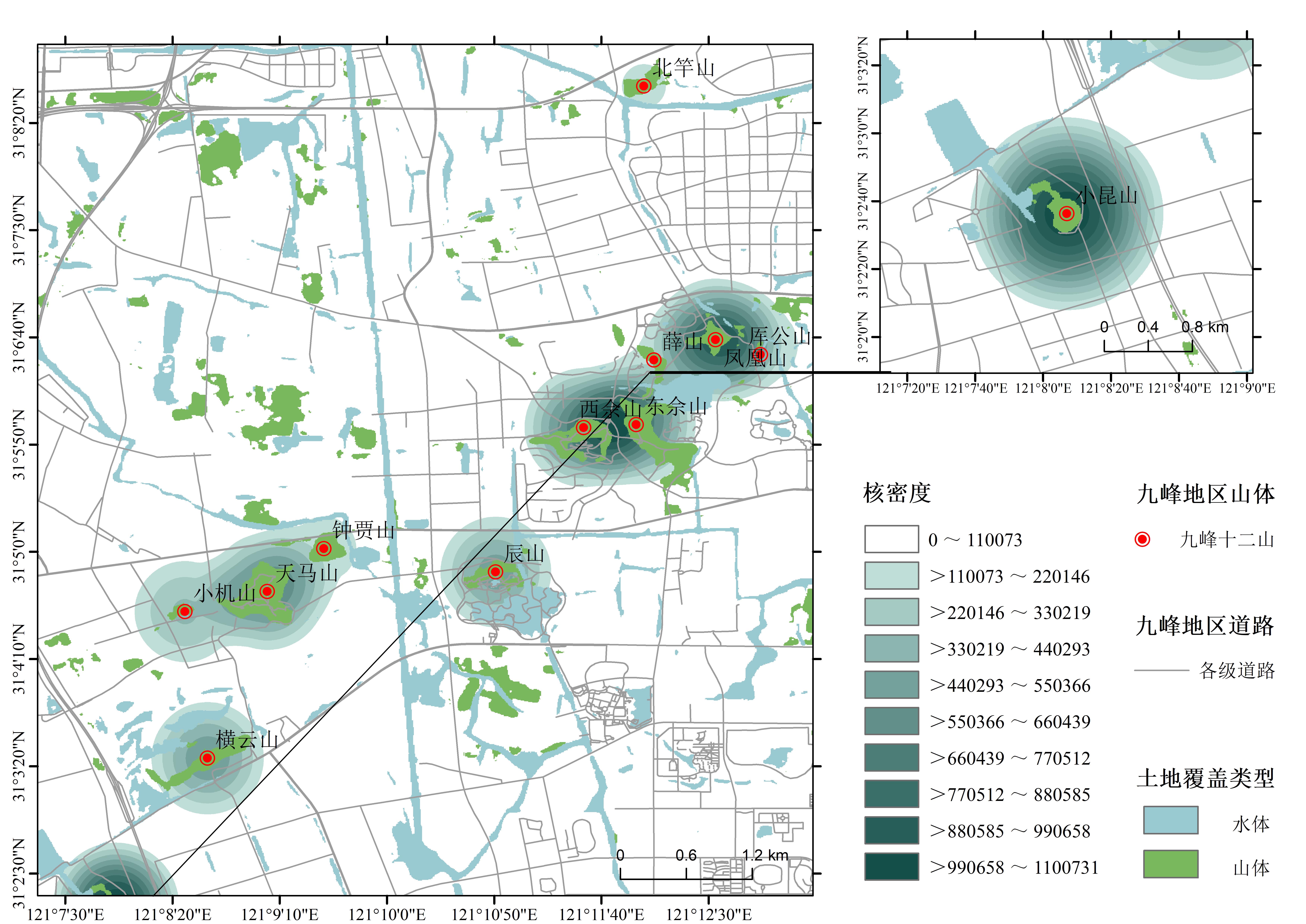
Xiaolan Tang , Jiaqi Xu . Exploration of Landscape Spatial Imagery in the Jiufeng Area of Songjiang, Shanghai, Based on Digital Humanities Technology[J]. Tropical Geography, 2025 , 45(3) : 449 -459 . DOI: 10.13284/j.cnki.rddl.20240154
表1 物象分类与词频统计Table 1 Object classification and word frequency statistics |
| 物象类型分类(频次/次) | 九峰整体物象分类(频次/次) | |
|---|---|---|
| 自然景观物象 | 天景(943) | 晨昏(265)、风烟(222)、四季(166)、云霞(159)、细雨(99)、霜露(32) |
| 地景(779) | 山峰(598)、岩石(62)、稻田(51)、崖壁(39)、洞穴(29) | |
| 水景(567) | 江河(188)、流泉(103)、水潭(84)、波涛(59)、湖泊(58)、滨岸(51)、芳洲(24) | |
| 生景(533) | 林木(197)、茂林(90)、群芳(80)、鹤鸟(77)、水草(45)、绿苔(26)、鱼类(18) | |
| 共计(2 822) | ||
| 人文景观物象 | 建筑(737) | 船只(181)、居室(222)、村落(96)、寺院(62)、亭台楼阁(58)、高塔(45)、坟冢(39)、遗迹(34) |
| 人物(286) | 贤才(78)、宾朋(78)、高士(51)、农户(51)、仙翁(28) | |
| 声景(99) | 歌声(39)、竹乐(26)、鹤唳(19)、钟声(15) | |
| 道路(75) | 小径(41)、平桥(24)、台阶(10) | |
| 共计(1 197) | ||
表2 词向量参数值Table 2 Values of word vector parameters |
| 参数 | 含义 | 设定值 |
|---|---|---|
| window | 句中预测词与当前词的最大距离 | 3 |
| vector_size | 所得词向量维度 | 150 |
| min-count | 最小词频训练的阈值,若词频小于 该阈值的词将不会被训练 | 1 |
| sg | 词向量训练时所用模型,CBOW为1,Skipgram为0 | 0 |
| workers | 线程数 | 64 |
| epochs | 训练迭代次数 | 200 |
表3 意象分类、组成与来源分析Table 3 Image classification, composition and source analysis |
| 景观空间意象 | 物象组成 | 情感组成 | 标准化中心度雷达图 (占比/%) | 意象来源分析 |
|---|---|---|---|---|
| 秋 月 泛 舟 | 自然景观物象: 江流、明月、细雨、秋日、水潭、波涛、滨岸等 | 主要情感:无 次要情感:欢欣(积极情感) | 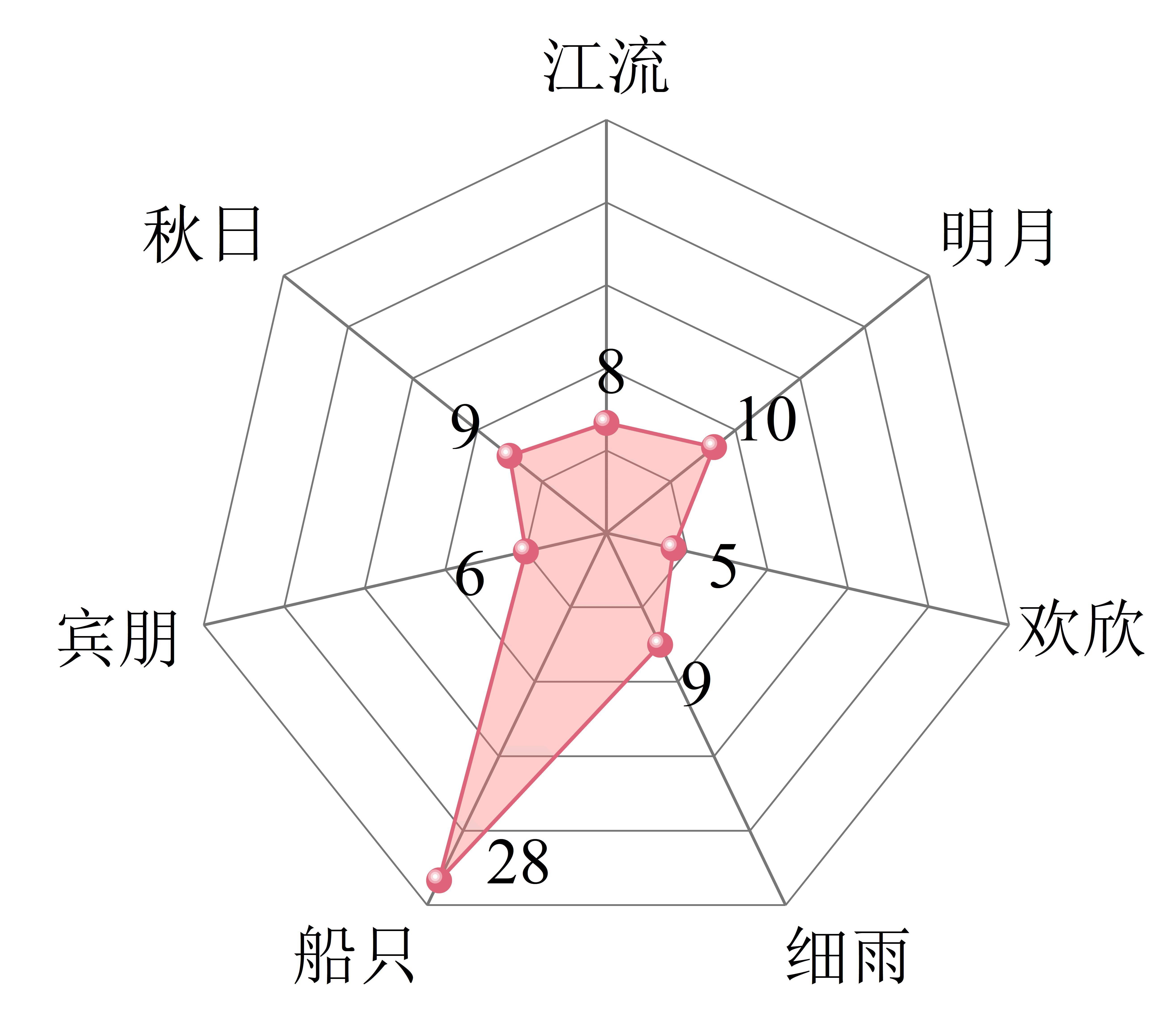 | 1. 秋夜泛舟,观山览水:“中宵急艇冲寒宿,数里惊涛带月来。……棹歌到处横江发,风壑清秋奏响哀。”(《泛泖》) 2. 与客泛舟,肆意同乐:“凤凰山下凤凰桥,与客移舟自海潮。……四时得意真行乐,一榻高眠慰久要。”(《八月九日月夜泊舟凤凰桥》) 3. 遥看山水,平江对月:“夜静山空月倍明,看山对月有余情。一轮艳彩河边转,数点螺鬟天际青。”(《山月轩》) |
| 人文景观物象:船只、 宾朋、亭台、 歌声等 | ||||
| 闲 适 幽 居 | 自然景观物象:稻田 | 主要情感: 平静(中性情感); 洒脱、悠然(积极 情感) 次要情感: 豪迈(积极情感) | 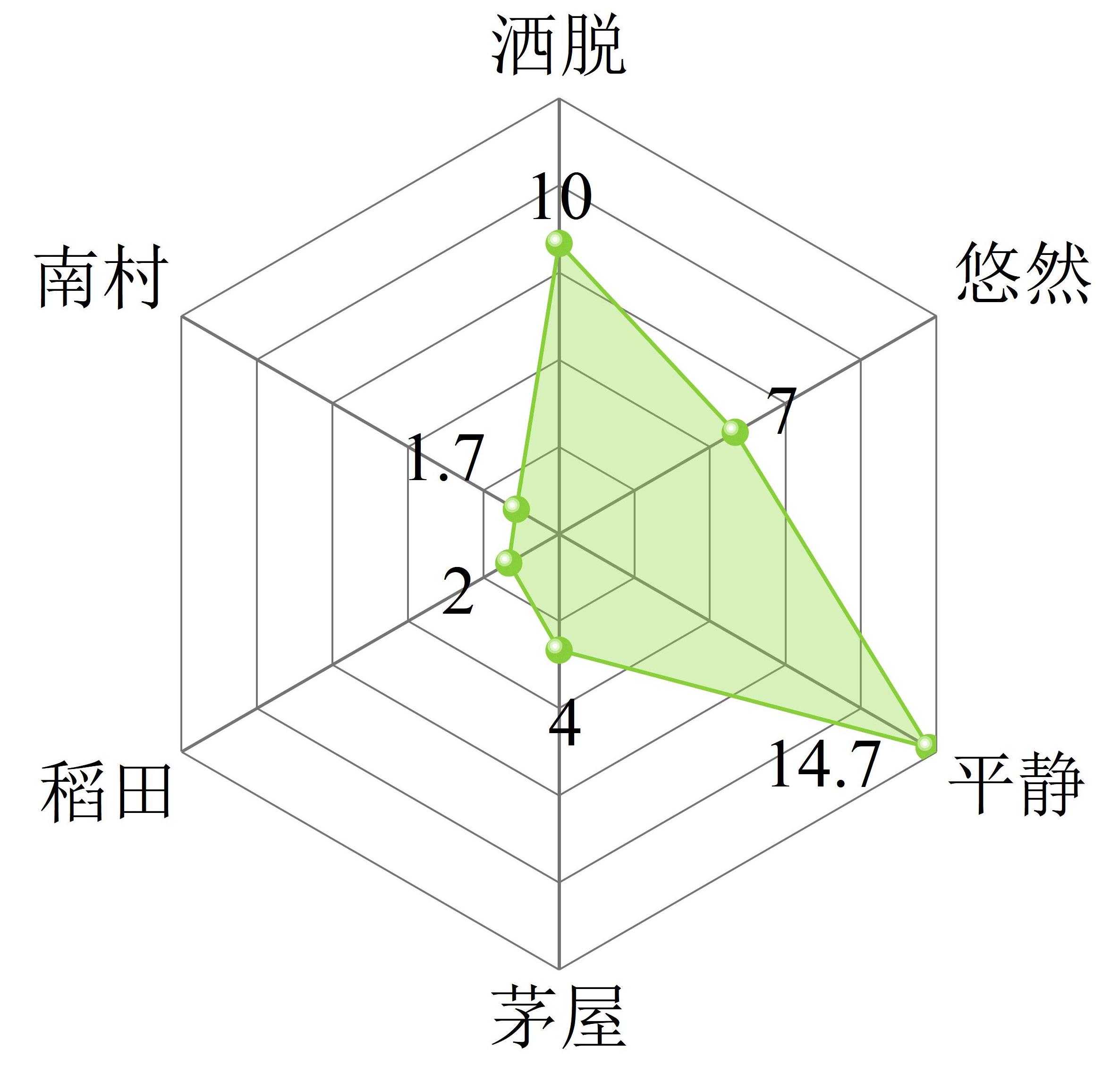 | 1. 岩居川观,淡薄超然:常有玉晨资赉十,未闻石户羡徵三。北来门外维船只惯,不为乘风利涉贪豪迈。(《赠陈仲醇徵君东佘山居诗三十首·其二十四》) 2. 田园风光,野村逸趣:为爱横山山水清,山前筑室小溪萦。老夫枕石看云卧,儿辈求田候雨耕。(《徙居横山口号》) |
| 人文景观物象:故居、 茅屋、南村、衣冠、酒水 | ||||
| 松 山 感 怀 | 自然景观物象:山麓、 东佘山居、松树 | 主要情感: 惋惜(消极情感) 次要情感:无 | 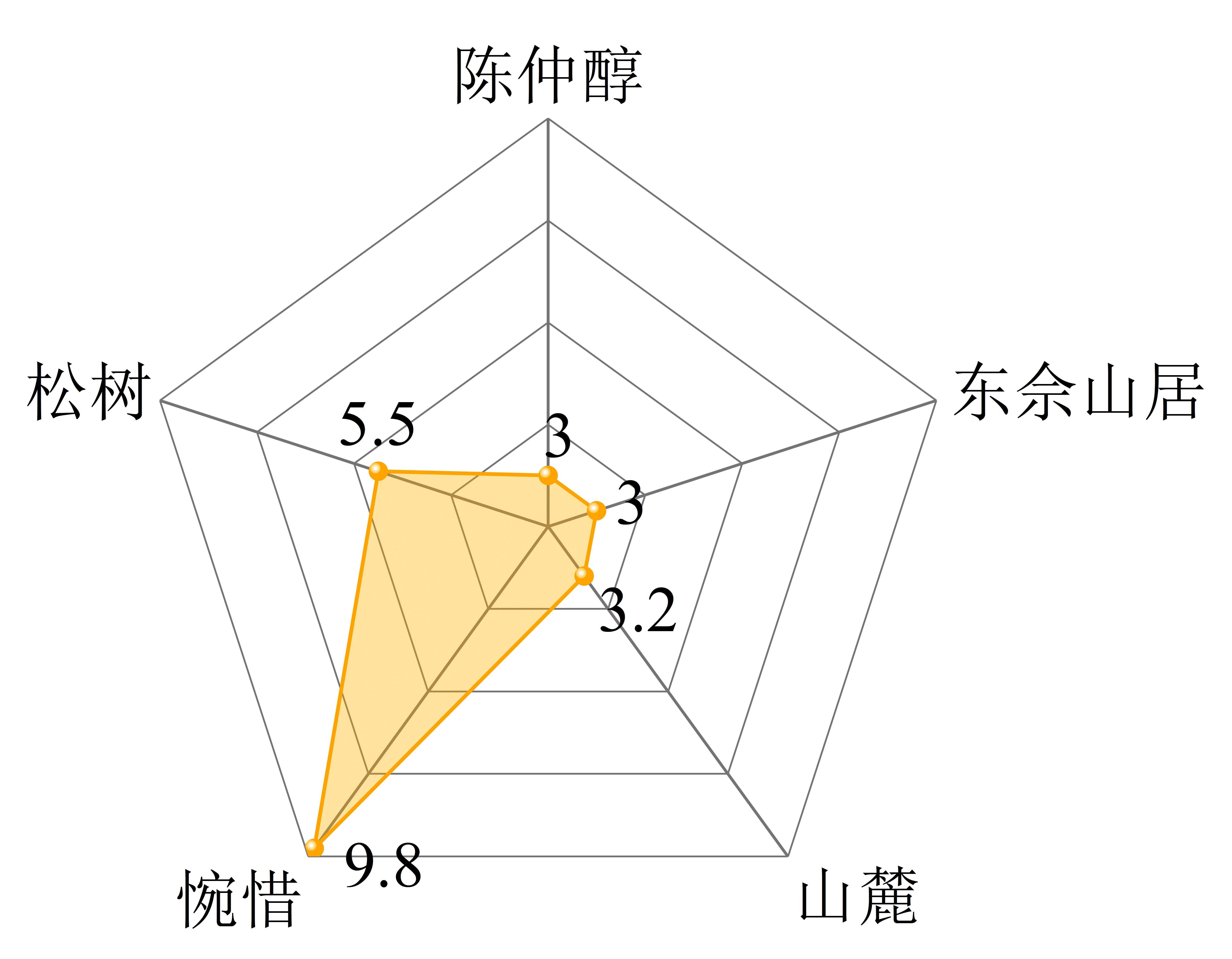 | 1. 故里风烟,逝去难返:“钟牙缅邈别家惭,试向瑶琴古调参。怀友经春哦渭北,教儿当日笑城南。”(《赠陈仲醇徵君东佘山居诗三十首·其十六》 2. 结庐人境,清净平远:山开窈窕藏书洞,径翳荒榛避诏岩。老衲或来煨榾柮,橐驼尝倩护松杉。(《赠陈仲醇徵君东佘山居诗三十首·其二》) |
| 人文景观物象:陈仲醇 | ||||
| 山 间 怀 想 | 自然景观物象:山峰、 云影、岩石、茂林、烟霭、晴日、春日、鹤鸟等 | 主要情感: 思怀(中性情感); 忧愁(消极情感) 次要情感: 喜爱(积极情感); 悲伤、凄凉 (消极情感) | 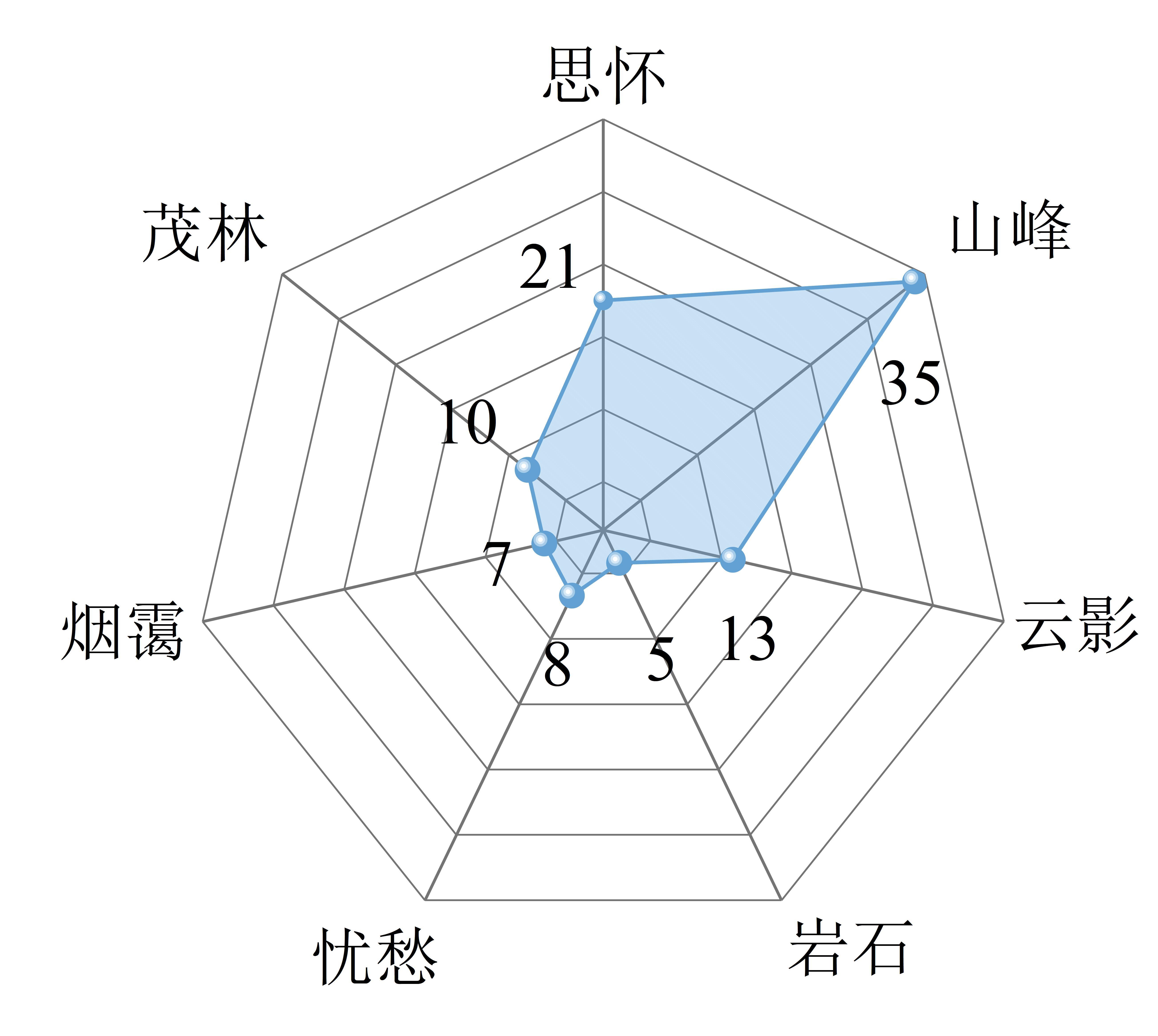 | 1. 抚今追昔,怀忆贤俊:“顾瞻山中云,遥睇月外树。缅怀陶公诗,临风起遐慕。”(《夜过凤凰山》) 2. 怀乡思旧,忧上心头:“故乡一片山林趣,写寄高斋慰别离。”(《题枯木竹石寄赠司训陈仲仁》) 3. 天光山色,情有独钟:“为爱云山搆小楼,看山看云今白头。山形起伏只如旧,云湿云晴知几秋。”(《题云山楼》) |
| 人文景观物象: 亭台、遗迹 | ||||
| 华 亭 山 水 | 自然景观物象: 溪流、山谷、昆山 | 主要情感:无 | 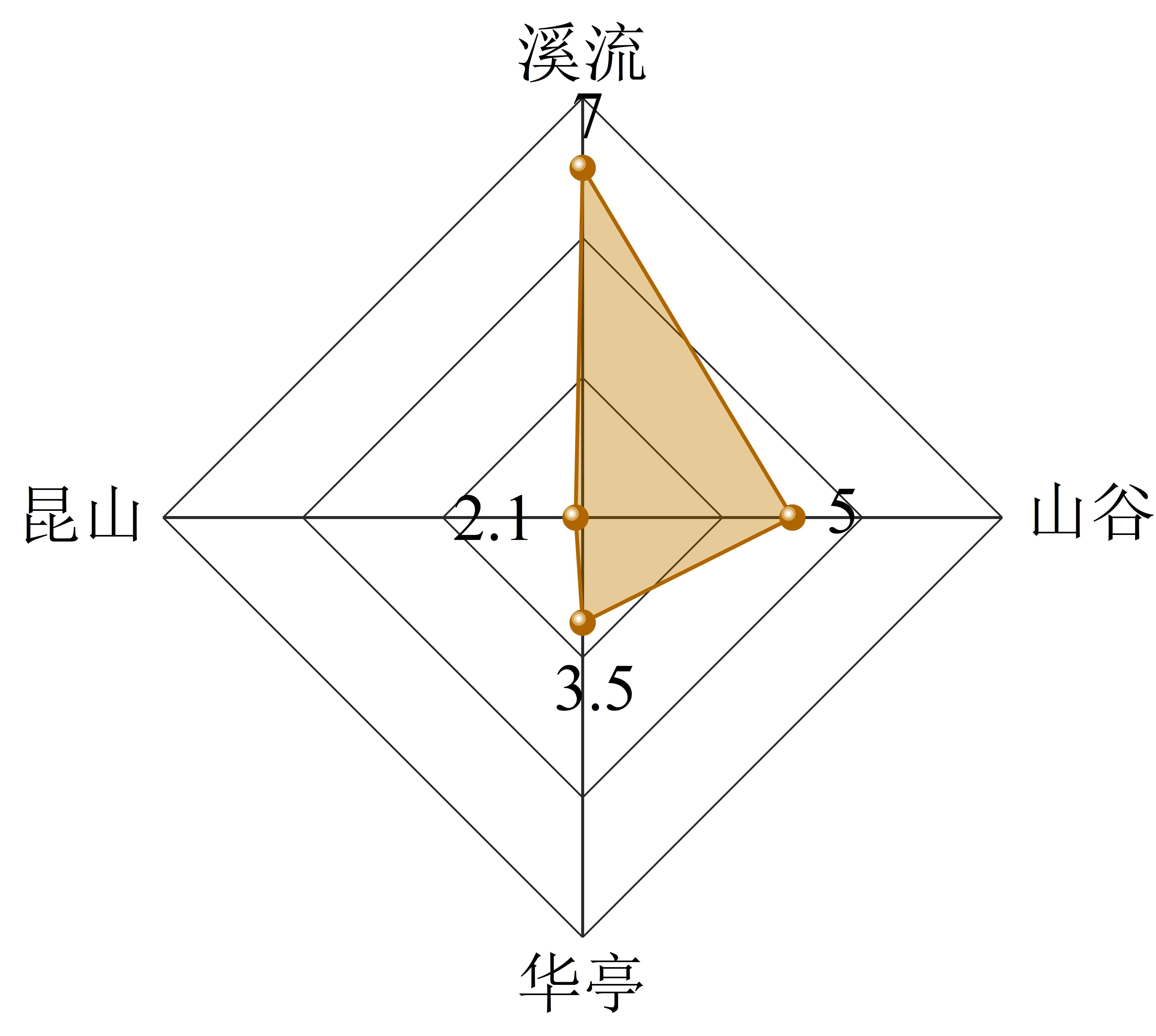 | 1. 昆山怀玉,今再难觅:故物一已尽,嗟此岁年深。野桃自著花,荒棘自生针。芊芊谷水阳,郁郁昆山阴。俛仰但如昨,游者不可寻。(《次韵唐彦猷华亭十咏 其八 陆机宅》) 2. 林泉探幽,景色怡人:沈沈香刹缘林出,杳杳茶烟隔涧浮。好共携筛陟层峨,红泉碧磴细探幽。(《同周梦兰放舟至横云山》) |
| 人文景观物象:无 |
1 https://github.com/Werneror/Poetry
唐晓岚:论文选题、研究设计、指导论文修改、基金支持;
徐嘉绮:数据分析、图表绘制、论文撰写与修改。
|
博润. 1988. 松江府续志. 扬州:江苏广陵古籍刻印社.
Bo Run. 1988. Songjiang Prefecture Chronicles. Yangzhou: Jiangsu Guangling Ancient Books Publishing House.
|
|
陈威,顾清. 2011. (正德)松江府志:三十二卷. 上海:上海古籍出版社.
Chen Wei and Gu Qing. 2011. (Zhengde) Songjiang Gazetteer: Volume XXXII. Shanghai: Shanghai Ancient Books Publishing House.
|
|
中国风景园林学会. 2021. 中国风景园林学会2021年会论文集. 北京:中国建筑工业出版社.
Chinese Society of Landscape Architecture. 2021. Proceedings of the China Society of Landscape Architecture Annual Meeting 2021. Beijing: China Architecture & Building Press.
|
|
丛昕,郭敏,陆婧,张清海. 2018. 传统村落景观意象营造中空间形态的解析. 南京艺术学院学报,(5):197-202.
Cong Xin, Guo Min, Lu Jing, and Zhang Qinghai. 2018. Analysis of Spatial Form in the Construction of Traditional Village Landscape Image. Fine Arts & Design, (5): 197-202.
|
|
丁华东,周子晴. 2023. 数字人文:数字时代社会记忆再生产的新景观. 情报科学,41(11):1-7,27.
Ding Huadong and Zhou Zijing. 2023. Digital Humanities: A New Landscape of Social Memory Reproduction in the Digital Age. Information Science, 41(11): 1-7, 27.
|
|
丁绍刚. 2011. 景观意象论——探索当代中国风景园林对传统意境论传承的途径. 中国园林,27(1):42-45.
Ding Shaogang. 2011. Theory of Yixiang (Image) in Landscape about Explore the Method of Chinese Contemporary Landscape Architecture Inheriting Traditional Yijing (Concept) Theory. Chinese Landscape Architecture, 27(1): 42-45.
|
|
巩帆. 2016. 阆中古城景观意象研究. 重庆:重庆大学.
Gong Fan. 2016. The Research on Landscape Image of Langzhong Ancient City. Chongqing: Chongqing University.
|
|
何惠明. 2004. 九峰志. 上海:上海辞书出版社.
He Huiming. 2004. Local Histories of Jiufeng. Shanghai: Shanghai Lexicographical Publishing House.
|
|
姜兆翀. 2022. 国朝松江诗钞. 上海:上海古籍出版社.
Jiang Zhaochong. 2022. Songjiang Area Poetry Collection of Qing Dynasty. Shanghai: Shanghai Ancient Books Publishing House.
|
|
加小双,徐拥军. 2019. 国内外记忆实践的发展现状及趋势研究. 图书情报知识,(1):60-66.
Jia Xiaoshuang and Xu Yongjun. 2019. Study on the Status and Trends of Memory Practice at Home and Abroad. Documentation, Information & Knowledge, (1): 60-66.
|
|
Koelsch W A. 2003. William H. Tillinghast, John K. Wright, and Some Antecedents of American Humanistic Geography. Journal of Historical Geography, 29(4): 618-630.
|
|
李畅,梁启凡,翟俊. 2024. 诗意的丈量——景观诗词文本挖掘与空间制图研究进展. 中国园林,40(4):103-108.
Li Chang, Liang Qifan, and Zhai Jun. 2024. Measuring Poetics: Research Progress in Landscape Poetry Text Mining and Spatial Mapping. Chinese Landscape Architecture, 40(4): 103-108.
|
|
李运龙,吴娜,王静静,罗鸿,邹淑珍. 2023. 生态发展视域下南京冶山工业遗迹景观意象重构. 包装工程,44(S1):541-547.
Li Yunlong, Wu Na, Wang Jingjing, Luo Hong, and Zou Shuzhen. 2023. The Reconstruction of Nanjing Yeshan Industrial Relic Landscape Image from the Perspective of Ecological Development. Packaging Engineering, 44(S1): 541-547.
|
|
廖丹. 2021. 明代松江书家群体与文人结社交游研究. 中国美术研究,(2):109-114,161.
Liao Dan. 2021. Study on the Mingling of Songjiang Calligrapher Group and Literati Association in Ming Dynasty. Research of Chinese Fine Arts, (2): 109-114, 161.
|
|
刘秋宇. 2021. 探究明末清初文人画的感伤主义情怀. 湖北:湖北美术学院.
Liu Qiuyu. 2021. On the Sentimentalism of Literati Paintings in the Late Ming and Early Qing Dynasties. Hubei: Hubei Institute of Fine Arts.
|
|
范文澜. 1958. 文心雕龙注. 北京:人民文学出版社.
Fan Wenlan. 1958. Bibliographic Annotations of Wenxindiaolong. Beijing: The People's Literature Publishing House.
|
|
马薛骑. 2022. 基于计算机视觉算法的武汉湖泊公园景观意象特征及感知偏好研究. 武汉:华中农业大学.
Ma Xueqi. 2022. A Study on Landscape Image and Perception and Preferences of Wuhan Lake Parks Based on Computer Vision Algorithm. Wuhan: Huazhong Agricultural University.
|
|
Mikolov T, Chen K, Corrado G, and Dean J. 2013. Efficient Estimation of Word Representations in Vector Space. (2013-01-16) [2023-10-15]. https://arxiv.org/abs/1301.3781.
|
|
潘超. 2023. 江山之助:国家景观视域下的天山意象重构. 美术,(12):19-29.
Pan Chao. 2023. The Help of Jiangshan: Reconstruction of the Tianshan Mountain Image from the Perspective of National Landscape. Art Magazine, (12): 19-29.
|
|
任向阳. 2009. 云间风物诗歌集. 上海:上海文艺出版社.
Ren Xiangyang. 2009. Shanghai Songjiang Local Scenery Poetry Collection. Shanghai: Shanghai Literature and Art Publishing House.
|
|
上海市文化和旅游局. 2022 上海市“十四五”文物保护利用规划. (2022-07-24)[2023-10-15]. https://whlyj.sh.gov.cn/jqxxgk/20220724/6bcf34185f4e4e8fa79d56ac5627cc25.html.
Shanghai Municipal Administration of Culture and Tourism. 2022. Shanghai "14th Five-Year Plan" Cultural Relics Protection and Utilization Plan. (2022-07-24) [2023-10-15]. https://whlyj.sh.gov.cn/jqxxgk/20220724/6bcf34185f4e4e8fa79d56ac5627cc25.html.
|
|
唐晓岚,宋天锐. 2024. “符号—凝视—镜像”视域下名山景观探赜:以浙江乍浦九山为例. 园林,41(1):85-92.
Tang Xiaolan and Song Tianrui. 2024. Exploring the Landscape of Famous Mountains in the Field of "Symbol-Gaze-Mirror": A Case of Zhapu Nine Mountains in Zhejiang Province. Landscape Architecture Academic Journal, 41(1): 85-92.
|
|
王培洪,李可润,吴小刚. 2022. 基于乡情视角的闽南乡村景观意象评估. 华中农业大学学报,41(3):27-34.
Wang Peihong, Li Kerun, and Wu Xiaogang. 2022. Evaluation of Rural Landscape Image in Southern Fujian Based on the Perspective of Nostalgia. Journal of Huazhong Agricultural University, 41(3): 27-34.
|
|
文媛,张瑾,沈世伟. 2021. 传统村落旅游景观意象的社区感知研究——以江西省婺源县篁岭古村为例. 地域研究与开发,40(6):123-128.
Wen Yuan, Zhang Jin, and Shen Shiwei. 2021. Community Perception Research of Traditional Village Tourism Landscape Image: Taking Huangling Ancient Villiage, Wuyuan County in Jiangxi Province as Example. Areal Research and Development, 40(6): 123-128.
|
|
杨晴晴,杨效忠. 2022. 基于网络文本的廊道型旅游地意象研究——以皖南“川藏线”为例. 热带地理,42(4):674-684.
Yang Qingqing and Yang Xiaozhong. 2022. The Image of Corridor Tourism Destination Based on Internet-Text: A Case Study of Southern Anhui "Sichuan-Tibet Line". Tropical Geography, 42(4): 674-684.
|
|
郑嫣然,刘雷,斯震. 2018. 景观意象下的诗化符号——基于符号学背景下的地域文化特色探究. 中国园林,34(8):74-77.
Zhen Yanran, Liu Lei, and Si Zhen. 2018. The Poetic Symbol under Landscape Imagery: The Regional Culture Characteristics Exploration Based on the Background of Semiotics. Chinese Landscape Architecture, 34(8): 74-77.
|
/
| 〈 |
|
〉 |